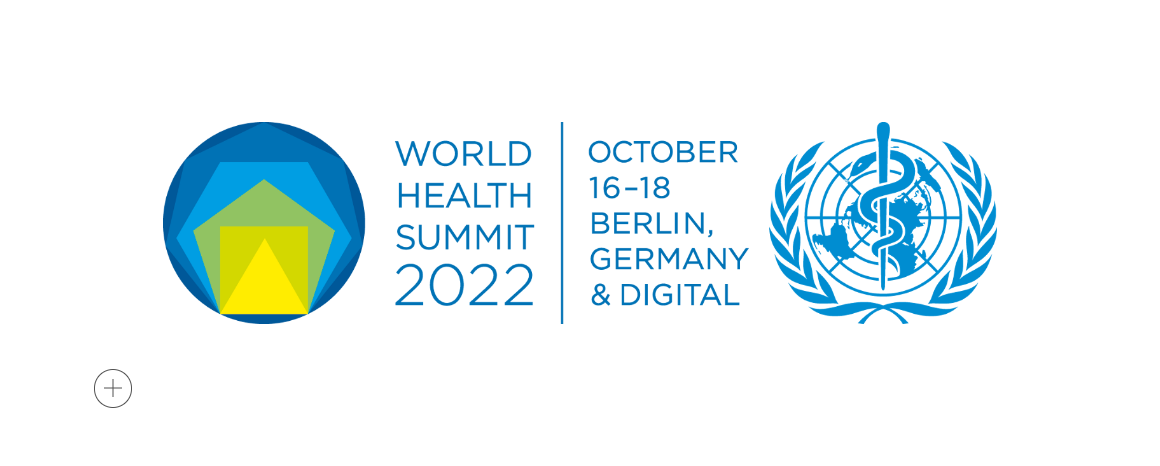World Health Summit
Accessed on October 18, 2022
Site Editor:
Joaquim Cardoso MSc.
health transformation institute (HTI)
October 18, 2022
This year’s World Health Summit will focus on “Making the Choice for Health” by reflecting on the most pressing topics, including:
- 1.Investment for Health and Well-Being
- 2.Climate Change and Planetary Health
- 3.Architecture for Pandemic Preparedness
- 4.Digital Transformation for Health
- 5.Food Systems for Health
- 6.Health Systems Resilience and Equity
- 7.Global Health for Peace
1.Investment for Health and Well-Being
The urgency of sustainable and equitable investing in health and well-being is proving to be more important than ever given today’s intersecting global challenges.
There have been extensive discussions on the need to increase investments in health especially following the impact of the COVID19 pandemic; financial institutions are more engaged and several new financial instruments have been proposed.
While there has been a shift towards responsible investment by private and by institutional investors — especially with regard to climate impact — more needs to be done to ensure that large financial flows support health, improve the health impact of economic actors and to widen the ESG approach to include health considerations.
As vulnerable and marginalized people groups are particularly affected, investment targeted to health and its determinants also plays a crucial role for health equity.
… more needs to be done to ensure that large financial flows support health, improve the health impact of economic actors and to widen the ESG approach to include health considerations.

2.Climate Change and Planetary Health
Climate change is the biggest threat for global health.
Millions of people are victims of heat waves, droughts, floods and storms, hunger and the spread of infectious diseases, sea level rise and resulting migration and political instability.
We see significant new health inequities emerging as a consequence.
Climate change is the biggest threat for global health.
Bold new approaches to policy making, research, and business are needed in order to change course.
An unprecedented challenge demands an unprecedented response.
New coalitions are emerging between health and climate advocates and activists and international organizations such as the World Health Organization (WHO) are building the evidence and creating alliances to put this agenda at the center of global health action.
New transformation pathways in the health sector and beyond both on local and global levels need to be developed.
- One pathway is for countries and health systems to set the goal for net zero carbon emission in health systems and to support LMIC to decarbonize systems as they develop UHC and primary health care.
- Another is for the public health community to fully integrate the planetary health agenda.
Bold new approaches to policy making, research, and business are needed in order to change course.

3.Architecture for Pandemic Preparedness
Despite considerable effort invested in global pandemic preparedness over the last two decades, …
.. the COVID-19 pandemic has underscored the need to be better prepared to identify and respond to new pandemic and epidemic threats.
Several high-level panels and commissions have recommended to the global public health architecture, while both the G7 and the G20 have pandemic preparedness high on their agendas.
A major challenge at both the global and country levels is how to build stronger and smarter surveillance, …
… especially for rapid detection of unknown pathogens, coupled with effective decision-making and response capabilities.
A fundamental reality is that stronger pandemic and epidemic intelligence requires that all countries are better prepared and able to collaborate with each other effectively.
A fundamental reality is that stronger pandemic and epidemic intelligence requires that all countries are better prepared and able to collaborate with each other effectively.
For this, structural aspects are important such as
- international legal frameworks,
- financing mechanisms,
- improved multi-sectoral collaboration, and
- the strengthening of existing global public health organizations, including the World Health Organization.

4.Digital Transformation for Health
The digital transformation of health is progressing with great speed.
Today digital technologies represent an essential component on the path to health literacy, sustainable health systems and universal health coverage.
Fundamental changes are currently taking place in healthcare with regard to the way medical care is delivered and information is procured and disseminated.
Digital Health First strategies are being developed rapidly as many large tech companies enter the health arena.
The role of the major tech platforms in relation to reliable health information has been prominent during the COVID-19 pandemic and infodemics have become a major threat to health.
These developments have led to new forms of cooperation between international organizations and the tech industry at the global level.
However, in many countries, significant investments in both health and digital infrastructure are needed and the regulatory environment is weak.
There is concern about data extraction and loss of digital sovereignty.
Countries need robust digital health strategies that integrate leadership, financial, organizational, human and technological resources as well as support to address the major impediments they face.
Countries need robust digital health strategies that integrate leadership, financial, organizational, human and technological resources as well as support to address the major impediments they face.
There is concern about data extraction and loss of digital sovereignty, to be addressed.

5.Food Systems and Health
Food systems are making us ill, driving climatic change and undermining the health of ecosystems.
Food lies at the heart of human, ecosystem and animal health.
The agenda is big:
- we must change the way we think about, produce, distribute, consume, dispose of and value food,
- for better health outcomes.
There are five interconnected and interrelated pathways:
- unhealthy diets and food insecurity;
- zoonotic pathogens and antimicrobial resistance;
- unsafe and adulterated foods;
- environmental contamination and degradation and occupational hazards.
We need transformative systems change to shift food systems towards the delivery of sustainable healthy diets for all.
If food systems are transformed, they can become a powerful driving force towards ending hunger, food insecurity and malnutrition in all its forms.
The package of actions comprises of
- taxing unhealthy options and subsidizing healthy options,
- protecting children from harmful marketing of food and beverages,
- ensuring clear and accurate nutrition labels,
- reducing the levels of salt, sugars and harmful fats in processed food and drink products,
- fortifying staple foods by adding extra vitamins and minerals,
- ensuring nutritious foods for healthier diets are served or sold in schools, hospitals and other public places,
- improving surveillance of and response to foodborne diseases and
- assessing and strengthening national food control systems.
We need transformative systems change to shift food systems towards the delivery of sustainable healthy diets for all.

6.Health Systems Resilience and Equity
Both health systems resilience and health equity are key for an effective and efficient response to crises such as COVID-19.
If a health system is unable to withstand the pressures from a shock, it may cease to function or collapse, leaving in particular the most vulnerable at risk.
Therefore an urgent need for global and national commitment for sustained progress towards universal health coverage and health security is essential combined with a consistent commitment to equity.
This requires an integrated approach to building and rebuilding health systems that serve the needs of the population, before, during and after public health emergencies.
Adjustments to
- long-term changes,
- continuous learning,
- essential public health functions,
- strong primary health,
- all-hazards emergency risk management and
- engaging the whole-of-society are required.
WHO has issued seven policy recommendations on building resilient health systems based on primary health care and WHO’s health inequality monitoring provides an evidence base for equity-oriented policies, programs and practices aimed at closing existing gaps.
…an urgent need for global and national commitment for sustained progress towards universal health coverage and health security is essential combined with a consistent commitment to equity.

7.Global Health for Peace
The world is seeing the greatest number of conflicts since the end of WWII; two billion people, or a quarter of the world’s population, now lives in conflict-affected areas according to the United Nations.
In response the World Health Organization (WHO) has launched the Global Health for Peace Initiative (GHPI) which aims to position health as an influencer of peace and the WHO as an actor that helps sustain peace through health interventions that are conflict-sensitive and deliver peace outcomes in conflict-affected areas.
The GHPI promotes and supports the development of health programs that take into account peace and conflict dynamics, and, where possible, contribute to peace outcomes.
Based on the “Do no harm” principle it aims to design interventions that are sensitive to conflict dynamics, drivers, and actors and it seeks ways to contribute to peace outcomes while pursuing health objectives.
It includes Mental Health and Psychosocial Support, Community dialogue and Inclusive health promotion initiatives.
Health interventions can make a real difference, they can serve as a starting point for bringing people together.
They also contribute to enable and enhance dialogue, participation, inclusiveness, and trust-building.
The world is seeing the greatest number of conflicts since the end of WWII; two billion people, or a quarter of the world’s population, now lives in conflict-affected areas according to the United Nations.
Originally published at https://www.worldhealthsummit.org.
Related Articles












